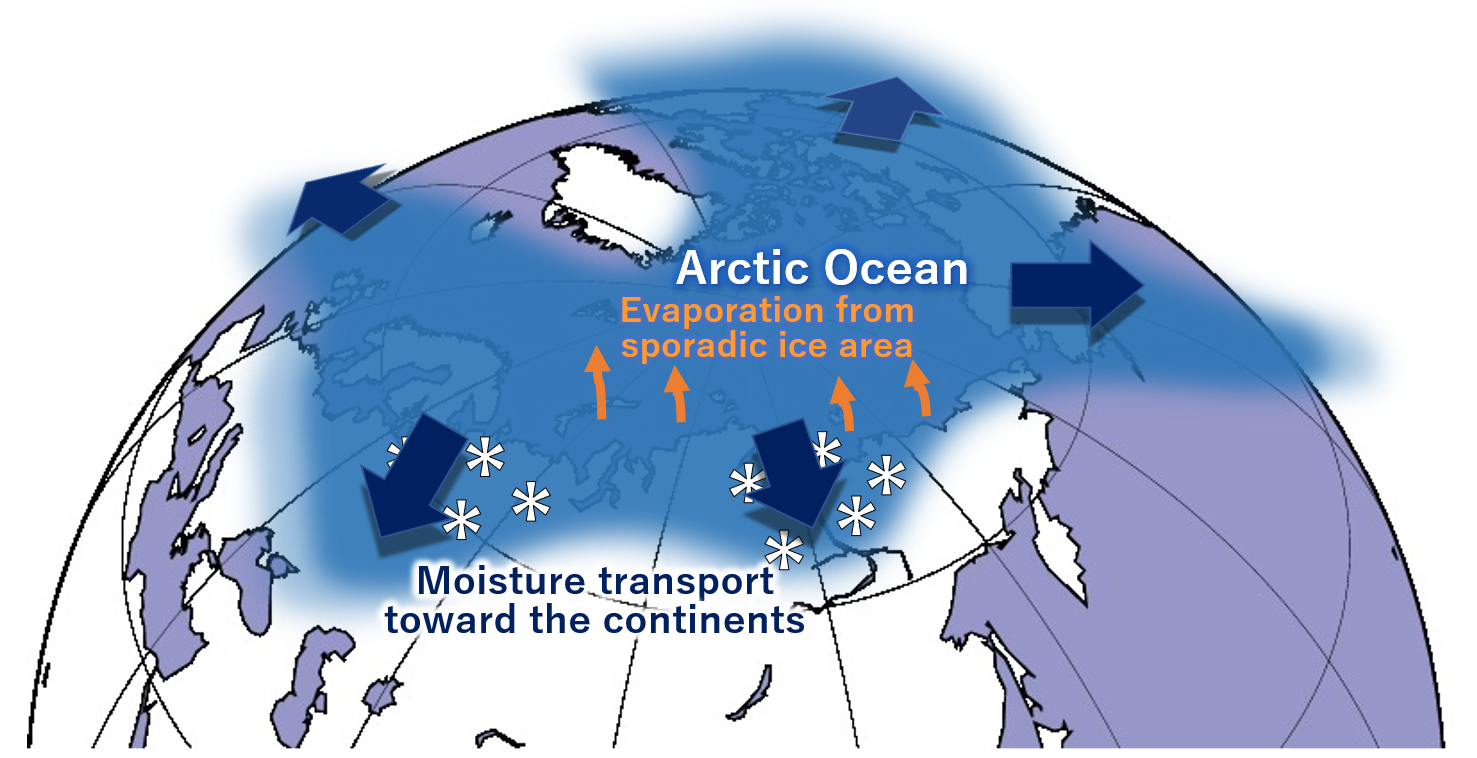As a result of the warming climate, a new model describes that water evaporating from the Arctic Ocean has been transported to the south and resulted in high snowfall in northern Eurasia in early winter and late autumn. This data will enable more precise forecasts of extreme weather events.
 An increasingly warm and ice-free Arctic Ocean has, in recent decades, led to more moisture in higher latitudes. This moisture is transported south by cyclonic weather systems where it precipitates as snow, influencing the global hydrological cycle and many terrestrial systems that depend on it. Image Credit: Tomonori Sato.
An increasingly warm and ice-free Arctic Ocean has, in recent decades, led to more moisture in higher latitudes. This moisture is transported south by cyclonic weather systems where it precipitates as snow, influencing the global hydrological cycle and many terrestrial systems that depend on it. Image Credit: Tomonori Sato.
Due to global warming, increasing air temperatures melt glaciers and polar ice caps. Apparently, paradoxically, snow cover in a few regions in northern Eurasia has increased over the last 10 years.
But snow is a form of water; global warming raises the quantity of moisture in the air, and thus the quantity and probability of snow and rain. Comprehending where exactly the moisture originates, how it is generated, and how it has been transported south seems to be appropriate for improved predictions of extreme weather and the progress of the climate.
Environmental Scientist Tomonori Sato from Hokkaido University and his team came up with a highly tagged moisture transport model that depends on the so-called “Japanese 55-year reanalysis dataset.” It is a painstaking reanalysis of worldwide historical weather data over the span of the past 55 years.
The group utilized this material to retain their model calibrated over really long-time distances compared to the previously possible and, thus, able to provide new insights into the mechanism of moisture transport, especially over the immense landmasses of Siberia.
A standard method to examine moisture transport is the “tagged moisture transport model.” This is a computer modeling method that tracks where hypothetical parts of atmospheric moisture form, how they have moved nearby, and where they precipitate as a result of the local climatic conditions.
However, the computer models turn out to be immensely incorrect as the distance to the ocean tends to increase. Mainly, this makes quantitative predictions hard. Hence, such techniques have not been able to favorably describe the snowfall in northern Eurasia.
The study outcomes, published in the journal npj Climate and Atmospheric Science, display that water evaporation caused by the Arctic Ocean has increased over the last 40 years. Also, the greatest variations have happened from the Barents and Kara Seas north of western Siberia, as well as over the Chukchi and East Siberian Seas north of eastern Siberia, between the month of October and December.
During this time of year, the Arctic Ocean still continues to warm and the area not covered by ice seems to be still large. Significantly, this development matches with the area where sea ice retreat has been powerful over the study’s time frame.
Besides, the quantitative model displays that snowfall and evaporation are particularly powerful during a few weather events like cyclonic systems taking up remarkably huge quantities of moisture and shipping them south into Siberia. As a result, elaborate and particular mechanistic visions of the region’s weather dynamics are stressed.
Since the Arctic Ocean is twice as sensitive to rapid warming compared to the global average, evaporation and understanding variations to the hydrological cycle over northern Eurasia will turn out to be highly pronounced in the years to come.
The scientists say that as snowfall frequently delays the downstream impacts of the abnormal weather events that cause it, “knowledge of the precursor signal stored as a snow cover anomaly is expected to help improve seasonal predictions of abnormal weather, e.g., the potential for heatwaves that enhance the risk of fire in boreal forests.”
Hence, this study harvests a main component to comprehending the mechanism of this weather system as well as others that are impacted by it. Also, to make improved predictions of severe events that could hurt people and infrastructure.
This study was financially supported by the Japan Society for the Promotion of Science KAKENHI (JP19H05668); the Arctic Challenge for Sustainability II (ArCSII) project (JPMXD1420318865); and the Japan Science and Technology Agency (JST) SICORP (JPMJSC1902).
Journal Reference:
Sato, T., et al. (2022) Enhanced Arctic moisture transport toward Siberia in autumn revealed by tagged moisture transport model experiment. npj Climate and Atmospheric Science. https://doi.org/10.1038/s41612-022-00310-1